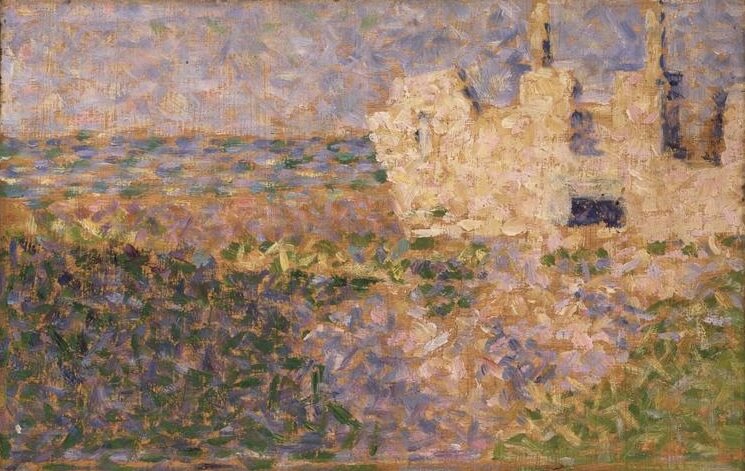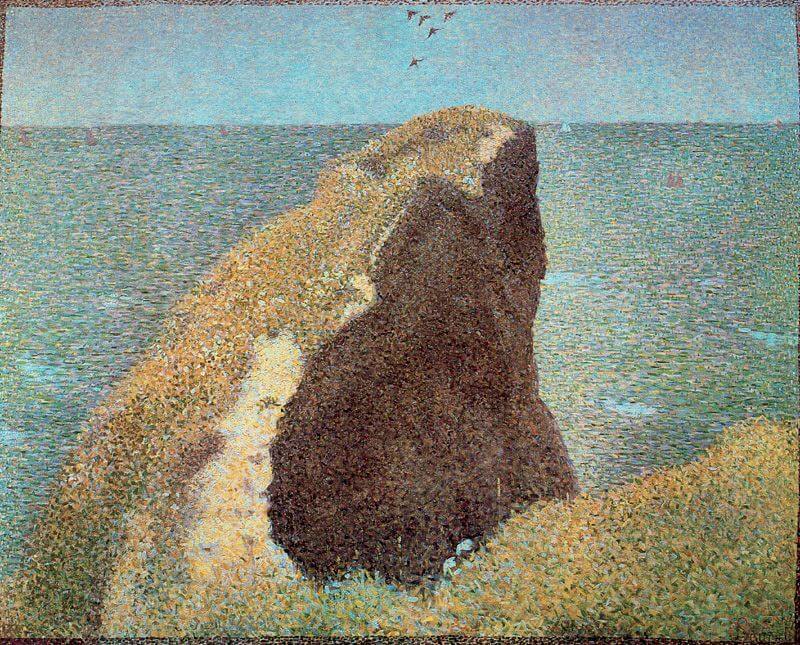|
Where? Floor 5, Gallery 1 of the Museum of Modern Art When? 1885 What do you see? The arrival of the evening in Grandcamp on the Northwest coast of France. The sky is a beautiful combination of white, silver, and gray. On the right is the Atlantic Ocean with a single sailboat. Seurat painted the sea and the sky using small horizontal brush strokes to indicate the direction in which the sea and sky are moving. In contrast, he painted the using dots of paint, which you can see very clearly when standing close to the painting. Some of the objects are very unclear from up-close. For example, look at the sailboat on the sea. However, from a distance, all the dots and small brush strokes come together, and the different elements of the painting become very clear. From a distance, we have no problem identifying a sailboat in this painting. Backstory: In 1885, Seurat spent his Summer in Grandcamp, Normandy, on the French coast. That Summer he painted several seascapes. Two examples of other works he created in Grandcamp that Summer are Ruins at Grandcamp in the Musée d’Orsay and Le Bec du Hoc, Grandcamp in Tate Modern.
Beyond Impressionism: Impressionism developed under the lead of Édouard Manet in the 1860s, and by the 1880s, Impressionism gained quite some popularity. However, among the next generation of artists, there were several innovative painters that went beyond Impressionism, usually labeled under the umbrella term Post-Impressionism.
What is Neo-Impressionism? An art movement created by Georges Seurat in 1884. Neo-Impressionism involved a scientific interpretation of colors and lines. The paint was applied in pure, unmixed dots and blocks of colors, creating a strong sense of organization. Scientific principles guided the choice of contrasting colors such that the colors interacted optically (instead of mixing the colors in the painting). This creates a special effect for the viewer. Looking at the paintings from nearby, one sees a lot of dots of pure colors. However, from a distance, these colors interact beautifully, and the painting becomes a unified whole of almost unmatched clarity. One great example of this style from 1892 is Femmes au Puits by Paul Signac in the Musée d’Orsay. A later example from 1902 is Old Woman by Pablo Picasso in the Philadelphia Museum of Art.
Who is Seurat? Georges-Pierre Seurat (1859-1891) was born and raised in Paris. He only became 31 years old and died in the midst of his career from an unknown disease. He was a Post-Impressionist painter. He can be classified even more accurately as a Neo-Impressionist painter.
Seurat received a classical art training at the traditional École des Beaux-Arts in Paris. While his painting style was far from traditional, his ideas benefited greatly from his education. He used a scientific approach to painting, whereby different colors can create different emotions and combining specific colors can create harmony in a painting. Seurat decided not to combine colors in a painting, but instead to apply the colors separately, using small dots, and let the viewer combine the colors in his/her mind. The best-known painting by Seurat is A Sunday at La Grande Jatte – 1884 in the Art Institute of Chicago.
Fun fact: Seurat completed this painting in 1885. Only three years later, he added the border of the painting. He did this to increase the brightness of the colors. This addition perfectly fits with the ideas and style of painting that Seurat used. The colors are carefully chosen to complement each other, and the contrasting colors in the border make the painting itself, and especially the sea and the sky stand out more.
Interested in a copy for yourself? Poster
0 Comments
Leave a Reply. |
Categories
All
|
- Home
- Blog
-
Museums
- Alte Pinakothek
- Art Institute of Chicago
- Baltimore Museum of Art
- Barber Institute of Fine Arts
- Bargello
- Barnes Foundation
- British Museum
- Church of Sant’Anastasia
- Cleveland Museum of Art
- Courtauld Institute of Art
- Detroit Institute of Arts
- Frans Hals Museum
- Galleria Borghese
- Gallerie dell'Accademia
- Getty Museum
- Guggenheim
- Hermitage Museum
- Kunsthistorisches Museum
- Kunstmuseum Basel
- Legion of Honor Museum
- Louvre
- Mauritshuis
- Metropolitan Museum of Art
- Musee d’Orsay
- Museum of Fine Arts in Boston
- Museum of Modern Art
- National Gallery in London
- National Gallery of Art
- National Museum in Poznań
- Norton Simon Museum
- Ny Carlsberg Glyptotek
- Palace of Versailles
- Palazzo Pitti
- Palazzo Vecchio
- Petit Palais
- Philadelphia Museum of Art
- Prado
- Pushkin Museum
- Ravenna Art Museum
- Rijksmuseum
- San Diego Museum of Art
- Santa Maria delle Grazie
- St. Peter's Basilica
- Städel Museum
- Statens Museum for Kunst
- Tate Britain
- Tate Modern
- Timken Museum of Art
- Uffizi
- Vatican Museums
- Wallace Collection
-
Artists
- Altdorfer
- Anguissola
- Berlin Painter
- Bosch
- Botticelli
- Boucher
- Bronzino
- Bruegel the Elder
- Brunelleschi
- Cabanel
- Caillebotte
- Canova
- Caravaggio
- Carpeaux
- Cezanne
- Cimabue
- David
- Degas
- Delacroix
- De Maria
- Donatello
- El Greco
- Fontana
- Fra Angelico
- Fragonard
- Gauguin
- Gentileschi
- Gericault
- Gonzalez-Torres
- Goya
- Hals
- Hogarth
- Hokusai
- Ingres
- Leonardo da Vinci
- Lippi, Filippo
- Longhi, Barbara
- Lorrain
- Makovsky
- Manet
- Massys
- Matisse
- Merian
- Michelangelo
- Mochi
- Modigliani
- Monet
- Panini
- Parmigianino
- Perugino
- Picasso
- Pisanello
- Raphael
- Rembrandt
- Renoir
- Reynolds
- Rivera
- Rodin
- Rubens
- Scultori
- Seurat
- Steen
- Tintoretto
- Titian
- Toulouse-Lautrec
- Turner
- Uccello
- Van der Weyden
- Van Dyck
- Van Eyck
- Van Gogh
- Van Hemessen
- Vasari
- Velazquez
- Vermeer
- Veronese
- Vigée Le Brun
-
Locations
- Books
- About Us






